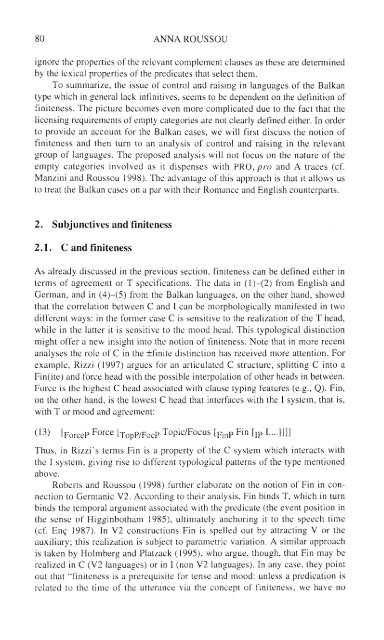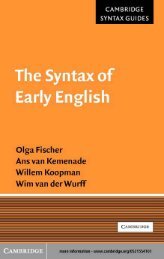Comparative Syntax of the Balkan Languages (Oxford ... - Cryptm.org
Comparative Syntax of the Balkan Languages (Oxford ... - Cryptm.org
Comparative Syntax of the Balkan Languages (Oxford ... - Cryptm.org
- No tags were found...
Create successful ePaper yourself
Turn your PDF publications into a flip-book with our unique Google optimized e-Paper software.
80 ANNA ROUSSOUignore <strong>the</strong> properties <strong>of</strong> <strong>the</strong> relevant complement clauses as <strong>the</strong>se are determinedby <strong>the</strong> lexical properties <strong>of</strong> <strong>the</strong> predicates that select <strong>the</strong>m.To summarize, <strong>the</strong> issue <strong>of</strong> control and raising in languages <strong>of</strong> <strong>the</strong> <strong>Balkan</strong>type which in general lack infinitives, seems to be dependent on <strong>the</strong> definition <strong>of</strong>finiteness. The picture becomes even more complicated due to <strong>the</strong> fact that <strong>the</strong>licensing requirements <strong>of</strong> empty categories are not clearly defined ei<strong>the</strong>r. In orderto provide an account for <strong>the</strong> <strong>Balkan</strong> cases, we will first discuss <strong>the</strong> notion <strong>of</strong>finiteness and <strong>the</strong>n turn to an analysis <strong>of</strong> control and raising in <strong>the</strong> relevantgroup <strong>of</strong> languages. The proposed analysis will not focus on <strong>the</strong> nature <strong>of</strong> <strong>the</strong>empty categories involved as it dispenses with PRO, pro and A traces (cf.Manzini and Roussou 1998). The advantage <strong>of</strong> this approach is that it allows usto treat <strong>the</strong> <strong>Balkan</strong> cases on a par with <strong>the</strong>ir Romance and English counterparts.2. Subjunctives and finiteness2.1. C and finitenessAs already discussed in <strong>the</strong> previous section, finiteness can be defined ei<strong>the</strong>r interms <strong>of</strong> agreement or T specifications. The data in (l)-(2) from English andGerman, and in (4)-(5) from <strong>the</strong> <strong>Balkan</strong> languages, on <strong>the</strong> o<strong>the</strong>r hand, showedthat <strong>the</strong> correlation between C and I can be morphologically manifested in twodifferent ways: in <strong>the</strong> former case C is sensitive to <strong>the</strong> realization <strong>of</strong> <strong>the</strong> T head,while in <strong>the</strong> latter it is sensitive to <strong>the</strong> mood head. This typological distinctionmight <strong>of</strong>fer a new insight into <strong>the</strong> notion <strong>of</strong> finiteness. Note that in more recentanalyses <strong>the</strong> role <strong>of</strong> C in <strong>the</strong> ifinite distinction has received more attention. Forexample, Rizzi (1997) argues for an articulated C structure, splitting C into aFin(ite) and force head with <strong>the</strong> possible interpolation <strong>of</strong> o<strong>the</strong>r heads in between.Force is <strong>the</strong> highest C head associated with clause typing features (e.g., Q). Fin,on <strong>the</strong> o<strong>the</strong>r hand, is <strong>the</strong> lowest C head that interfaces with <strong>the</strong> I system, that is,with T or mood and agreement:(13) [ Forcep Force l Top p/FocP Topic/Focus [ FinP Fin [, p !....]]]]Thus, in Rizzi's terms Fin is a property <strong>of</strong> <strong>the</strong> C system which interacts with<strong>the</strong> I system, giving rise to different typological patterns <strong>of</strong> <strong>the</strong> type mentionedabove.Roberts and Roussou (1998) fur<strong>the</strong>r elaborate on <strong>the</strong> notion <strong>of</strong> Fin in connectionto Germanic V2. According to <strong>the</strong>ir analysis, Fin binds T, which in turnbinds <strong>the</strong> temporal argument associated with <strong>the</strong> predicate (<strong>the</strong> event position in<strong>the</strong> sense <strong>of</strong> Higginbotham 1985), ultimately anchoring it to <strong>the</strong> speech time(cf. Enc, 1987). In V2 constructions Fin is spelled out by attracting V or <strong>the</strong>auxiliary; this realization is subject to parametric variation. A similar approachis taken by Holmberg and Platzack (1995), who argue, though, that Fin may berealized in C (V2 languages) or in I (non V2 languages). In any case, <strong>the</strong>y pointout that "finiteness is a prerequisite for tense and mood: unless a predication isrelated to <strong>the</strong> time <strong>of</strong> <strong>the</strong> utterance via <strong>the</strong> concept <strong>of</strong> finiteness, we have no
















